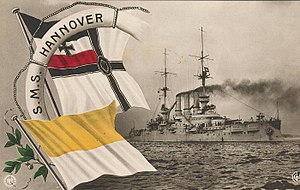SMS Hannover

SMS Hannover on a postcard in 1906.
|
|
| History | |
|---|---|
|
|
|
| Name: | Hannover |
| Namesake: | Province of Hanover |
| Builder: | Kaiserliche Werft Wilhelmshaven |
| Laid down: | 7 November 1904 |
| Launched: | 29 September 1905 |
| Commissioned: | 1 October 1907 |
| Fate: | Scrapped between 1944 and 1946 in Bremerhaven |
| General characteristics | |
| Class and type: | Deutschland-class pre-dreadnought battleship |
| Displacement: |
|
| Length: | 127.60 m (418 ft 8 in) |
| Beam: | 22.20 m (72 ft 10 in) |
| Draft: | 8.21 m (26 ft 11 in) |
| Propulsion: | 17,524 ihp (13,068 kW), three shafts |
| Speed: | 18 knots (33 km/h; 21 mph) |
| Range: | 4,520 nmi (8,370 km; 5,200 mi) at 10 knots (19 km/h; 12 mph) |
| Complement: |
|
| Armament: |
|
| Armor: |
|
SMS Hannover ("His Majesty's Ship Hannover") was the second of five Deutschland-class pre-dreadnoughts of the German Imperial Navy (Kaiserliche Marine). Hannover and the three subsequently constructed ships differed slightly in both design and construction from the lead ship Deutschland in their propulsion systems and slightly thicker armor. Hannover was laid down in November 1904 and commissioned into the High Seas Fleet in October 1907; this was ten months after the revolutionary "all-big-gun" HMS Dreadnought was commissioned into the Royal Navy. As a result, Hannover was obsolete as a capital ship before she was even completed; Dreadnought's more powerful main battery and higher speed would have made it unwise for a ship like Hannover to engage her in the line of battle. The ship was named after the Prussian province of Hannover, now in Lower Saxony.
Hannover and her sisters saw extensive service with the fleet. The ship took part in all major training maneuvers until World War I broke out in July 1914. Hannover and her sisters were immediately pressed into guard duties in the mouth of the Elbe River while the rest of the fleet mobilized. The ship took part in a number of fleet advances, which culminated in the Battle of Jutland on 31 May – 1 June 1916. During the battle, Hannover served as the flagship for the IV Division of the II Battle Squadron. After Jutland, Hannover and her three surviving sisters were removed from active duty with the fleet to serve as guard ships. In 1917, Hannover was briefly used as a target ship before being returned to guard duties in the Baltic Sea. The ship was decommissioned in December 1918, shortly after the end of the war.
...
Wikipedia
